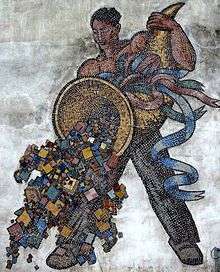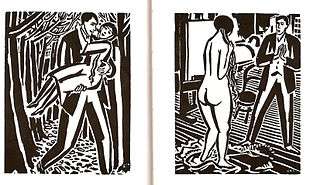Frans Masereel

Frans Masereel (31 July 1889 – 3 January 1972) was a Flemish painter and graphic artist who worked mainly in France. He is known especially for his woodcuts. His greatest work is generally said to be the wordless novel Passionate Journey. He completed over 20 other wordless novels in his career.
Masereel's woodcuts influenced Lynd Ward and later graphic artists such as Clifford Harper and Eric Drooker.
Biography
Frans Masereel was born in the Belgian coastal town Blankenberge on 31 July 1889. He moved to Ghent in 1896, where at the age of 18 he began to study at the École des Beaux-Arts in the class of Jean Delvin.[1] In 1909, he visited England and Germany, which inspired him to make his first etchings and woodcuts. In 1911 Masereel settled in Paris for four years and then emigrated to Switzerland, where he worked as a graphic artist for journals and magazines.

Masereel could not return to Belgium at the end of World War I because, being a pacifist, he had refused to serve in the Belgian army. Nonetheless, when a circle of friends in Antwerp interested in art and literature decided to found the magazine Lumière, Masereel was one of the artists invited to illustrate the text and the column headings. The magazine was first published in Antwerp in August 1919.[2] It was an artistic and literary journal published in French. The magazine's title Lumière was a reference to the French magazine Clarté, which was published in Paris by Henri Barbusse.[3] The principal artists who illustrated the text and the column headings in addition to Masereel himself were Jan Cantré, Jozef Cantré, Henri van Straten, and Joris Minne. Togethert,they became known as 'De Vijf' or 'Les Cinq' ('The Five').[4] Lumière was a key force in generating renewed interest in wood engraving in Belgium. The five artists in the 'De Vijf' group were instrumental in popularizing the art of wood, copper and linoleum engraving and introducing Expressionism in early 20th-century Belgium.[2][5]
Masereel's woodcut series, mainly of sociocritical content and expressionistic in form, made Masereel internationally known. Among them were the wordless novels 25 Images of a Man's Passion (1918), Passionate Journey (1919), The Sun (1919), The Idea (1920) and Story Without Words (1920). At that time Masereel also drew illustrations for famous works of world literature by Thomas Mann, Émile Zola, and Stefan Zweig.

In 1921 Masereel returned to Paris, where he painted his famous street scenes, the Montmartre paintings. He lived for a time in Berlin, where his closest creative friend was George Grosz. After 1925 he lived near Boulogne-sur-Mer, where he painted predominantly coast areas, harbour views, and portraits of sailors and fishermen. During the 1930s his output declined. In 1940 he fled from Paris and lived in several cities in Southern France.
At the end of World War II Masereel was able to resume his artistic work and produced woodcuts and paintings. After 1946 he taught at the Hochschule der Bildenden Künste Saar in Saarbrücken. In 1949 Masereel settled in Nice.[1] Between 1949 and 1968, he published several series of woodcuts that differ from his earlier "novels in picture'" in comprising variations on a subject instead of a narrative. He also designed decorations and costumes for numerous theatre productions. The artist was honoured in numerous exhibitions and became a member of several academies. Frans Masereel died in Avignon in 1972 and was entombed in Ghent. The cultural organization Masereelfonds was named after him, as was the Frans Masereel Centre studio facility at Kasterlee.
Influence
Masereel's woodcuts influenced Lynd Ward and later graphic artists such as George Walker, Clifford Harper, Eric Drooker, and New Yorker cartoonist Peter Arno.
List of works
Wordless novels in woodcuts
- Arise Ye Dead (Debout les Morts, 1917)
- The Dead Speak (Les Morts Parlent, 1917)
- 25 Images of a Man's Passion / The Passion of a Man (25 Images de la Passion d'un Homme / Die Passion Eines Menschen, 1918)
- Passionate Journey / My Book Of Hours (Mon Livre d'Heures / Mein Studenbuch, 1919)
- The Sun (Le Soleil / Die Sonne, 1919)
- Political drawings (Dessins Politiques / Politische Zeichnungen, 1920)
- Story Without Words (Histoire Sans Paroles / Geschichte ohne Worte, 1920)
- The Idea (L'Idée / Die Idee, 1920)
- The City (La Ville / Die Stad, 1925)
- Figures and Grimaces (Figures et Grimaces / Gesichter und Fratzen, 1926)
- The Work (L’œuvre, Das Werk, 1928)
- Landscapes and Voices (Landschaften und Stimmungen, 1929)
- The Siren (La Sirène, 1932)
- From Black to White (Du Noir au Blanc / Von Schwarz zu Weiss, 1939)
- Dance of Death (Danse Macabre, 1941)
- June '40 (Juin 40, 1942)
- Destinies 1939-1940-1941-1942 (Destins 1939-1940-1941-1942, 1943)
- Earth under the sign of Saturn (La Terre sous le signe de Saturne, 1944)
- Remember! (1946)
- Angel (Engel, 1947)
- Phenomena (Erscheinungen, 1947)
- Ages of life (Les Âges de la Vie, 1948)
- Youth (Jeunesse, 1948)
- Ecce Homo (1949)
- Key to Dreams (Clef des songes, 1950)
- Our Times (Notre Temps, 1952)
- The apocalypse of our time (Die Apokalypse unserer Zeit, 1953)
- Why? (Pour quoi?, 1954)
- My book of images (Mon livre d'images, 1956)
- My country (Mon Pais, 1956)
- Night Adventure (Aventure nocturne, 1958)
- Night and his Daughters (La Nuit et ses Filles, 1959)
- China Memories (Erinnerungen an China, 1961)
- Stations (É'talges, 1961)
- From Decay to Triumph (Vom Verfall zum Triumph, 1961)
- Poets (Poètes, 1963)
- The face of Hamburg (Das Gesicht Hamburgs / Le visage de Hambourg, 1964)
- The road of men (Der weg der menschen, Route des hommes, 1964)
- Couples (1965)
- My home (Meine Heimat, 1965)
- Antwerp (Antwerpen, 1968)
- Hands (Mains, 1968)
- Vice and passion (Laster und Leidenschaft, 1968)
- I love black and white (Ik houd van zwart en wit, 1970)
- Pictures against the war (Bilder gegen den Krieg, 1981)
- Woodcuts against the war (Holzschnitte gegen den Krieg, 1989)
Wordless novels in brush and ink drawings
- Grotesque Film (Groteskfilm, 1921)
- Pictures of the Big City (Bilder der Grossstadt / Images de la grande ville, 1926)
- Capital (Capitale, 1935)
- Wrath (La Colère, 1946)
Early works

- woodcuts in Demain (1916) and Les Tablettes (1916-1919)
- drawings in La Feuille (1917-1920)
Animated films
- collaboration with Berthold Bartosch on an animated adaptation of The Idea (L'Idée) (1932)
Woodcut book illustrations
- Hôtel-Dieu, Récits d'Hôpital (Hôtel-Dieu, Hospital Stories) by Pierre Jean Jouve (1915)
- Quinze Poemes (Fifteen Poems) by Émile Verhaeren (1917)
- Die Mutter (The Mother) by Leonhard Frank (1919)
- Bübü vom Montparnasse (Bubu of Montparnasse) by Charles-Louis Philippe (1920)
- Das Gemeinsame (The Common) by René Arcos (1920)
- Les Poètes contre la Guerre (The Poets Against War) by Romain Rolland, Georges Duhamel, Charles Vildrac and Pierre Jean Jouve (1920)
- Le Travailleur étrange et autres récits (The Strange Worker and Other Stories) by Émile Verhaeren (1921)
- Peter und Lutz (Peter and Lutz) by Romain Rolland (1921)
- Die Révolte der Maschinen, ou la Pensée Déchainée (The Revolt of Machines or the Mind Unbound, republished in 1947 as in Dutch as De opstand der machines, of Het losgebroken intellect) by Romain Rolland (1921)
- Fairfax by Carl Sternheim (1922)
- Cygne de Rabindranath Tagore (Swan of Rabindranath Tagore) by Kâlidâs Nâg and Pierre Jean Jouve (1923)
- Fünf Erzählungen (Five Tales) by Émile Verhaeren (1924)
- Heures (Hours) by Pierre Jean Jouve (1919)
- Liluli by Romain Rolland (1924)
- Prière (Pray) by Pierre Jean Jouve (1924)
- Jean-Christophe by Romain Rolland (1925)
- Kerstwake by Stijn Streuvels (1928)
- Swane (Swans) by Emmanuel De Bom (1928)
- Der Zwang. Phantastische Nacht (The Force. Fantastic night) by Stefan Zweig (1929)
- Im Strom der Zeit: Gedichte (In the Stream of Time: Poems) by Ernst Preczang (1929)
- De man zonder lijf (The Man Without a Body) by Herman Teirlinck (1937)
- Ode a la France Meurtrie (Ode to France) by Louis Piérard (1940)
- Jugement (Judgment) by Agrippa d'Aubigné (1941)
- La légende d’Ulenspiegel (The Glorious Adventures of Tyl Ulenspiegl) by Charles de Coster (1943)
- Die Nacht (The Night) by Rudolf Hagelstange (1955)
- Du bist für alle Zeit geliebt. Gedichte (You're Loved Forever. Poems) by Johannes R. Becher (1960)
- Vom Verfall zum Triumph (From Decline to Triumph) by Johannes R. Becher (1961)
- Dolle Dinsdag (Crazy Tuesday) by Theun De Vries (1967)
- Fleurs du mal (The Flowers of Evil) by Charles Baudelaire (1977)
- The Ballad of Reading Gaol by Oscar Wilde (1978)
References
- 1 2 Lambiek Comiclopedia. "Frans Masereel".
- 1 2 Joos Florquin, 'Ten huize van... 1', Davidsfonds, Leuven / Orion - Desclée De Brouwer, Bruges, 971, p. 270-299 (Dutch)
- ↑ Peter Brooker, Sascha Bru, Andrew Thacker, Christian Weikop, 'The Oxford Critical and Cultural History of Modernist Magazines: Europe 1880 - 1940', Oxford University Press, 19 May 2013, p. 330-331
- ↑ Modernist wood cut prints of Joris Minne
- ↑ PASSINGS : Joris Minne; Belgian Helped Revive Art of Engraving, April 02, 1988, Los Angeles Times
Peter Arno: The Mad, Mad World of The New Yorker's Greatest Cartoonist. Michael Maslin. Regan Arts, New York. 2016
Further reading
- Davide Di Maio: I romanzi per immagini di Masereel, in «Wuz», n. 1, gennaio-febbraio 2005, pp. 34–43.
- Kaplan, Arie (2008). From Kraków to Krypton: Jews and Comic Books. Jewish Publication Society. ISBN 978-0-8276-0843-6.
External links
| Wikimedia Commons has media related to Frans Masereel. |
- Frans Masereel Foundation site (German)
- International Institute of Social History, Amsterdam, Netherlands
- Nebulous Cargo - an observant walk through modern ruins
- Frans Masereel Centre, Artist in Residence - Belgium
- Politische Zeichnungen on the Internet Archive